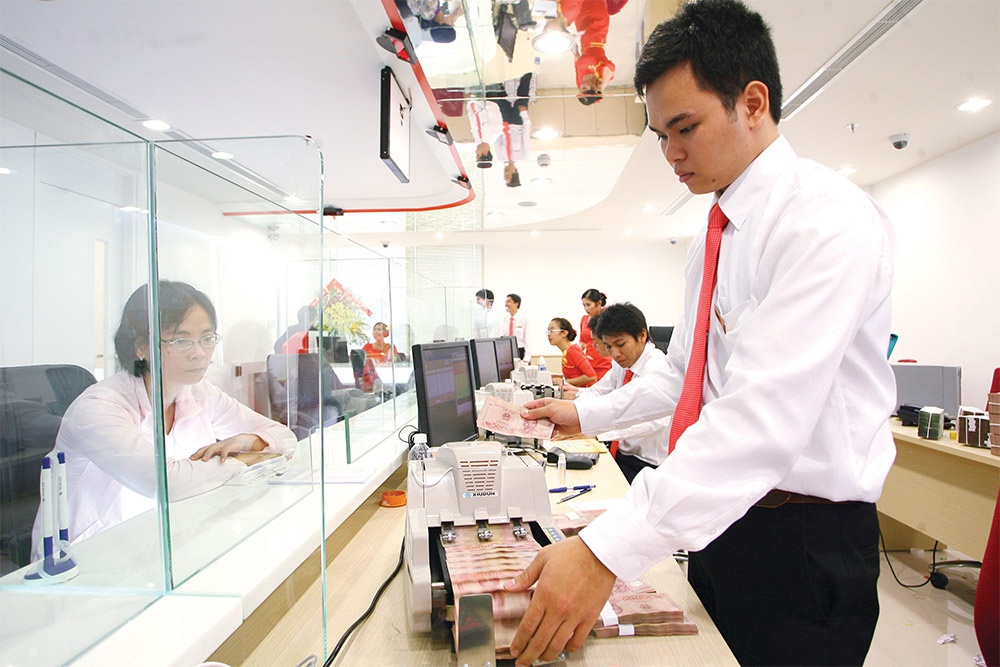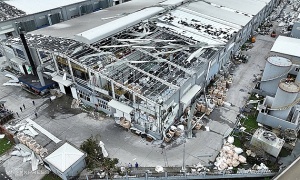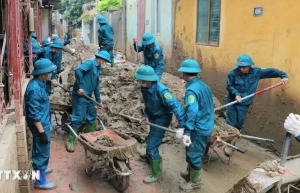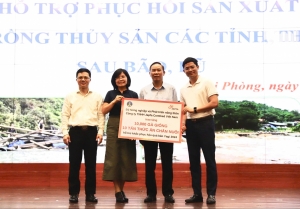Rebuilding lives a priority in aftermath of Typhoon Yagi
 |
| Banks have introduced special lending rates for those impacted by the typhoon, photo Le Toan |
Hoang Van Sy, director of SHB’s Lao Cai branch, revealed that the typhoon had caused significant damage to both the lives and property of SHB clients, with households and businesses bearing the brunt of the destruction. Following the storm, SHB sent staff to assess the damage and report back to management.
In response to calls from the government and the State Bank of Vietnam to aid recovery, SHB swiftly implemented a support programme for affected households and businesses.
“As part of this initiative, SHB will cover 50 per cent of interest payments from September 1 to December 31. For customers facing substantial losses, SHB may offer interest exemptions for the final four months of the year, depending on their level of damage. This is direct, immediate support for affected businesses and customers,” Sy said.
In addition, SHB introduced a special lending rate of 4.5 per cent per year for new loans to those impacted by the disaster.
Nguyen Tat Anh, acting CEO of Nam Luc hydropower plant in Lao Cai province severely affected by the typhoon, said that SHB Lao Cai has reduced the plant’s interest payments by 50 per cent, equating to over $416,000 through the end of the year, with half of this amount already reduced as of September.
Typhoon Yagi caused a landslide that buried Nam Luc’s administration building, leading to the tragic deaths of five employees. Rising river waters further exacerbated the situation, flooding the plant and making it inoperable.
“The extent of the storm’s destruction is vast. The estimated damage to our assets and infrastructure exceeds $4.1 million, not including operational downtime and lost revenue,” Anh said.
Nguyen Ba Hung, who is the principal country economist from the Asian Development Bank (ADB) in Vietnam, noted that Typhoon Yagi had severely impacted northern mountainous regions already struggling with economic growth. However, he highlighted the potential for recovery efforts to serve as an opportunity for improvement rather than mere restoration.
“Rebuilding efficiently could become a new driving force for development in these areas. In the short term, the state budget is the quickest way to mobilise resources. In the long term, developing markets such as insurance will enhance efficiency,” Hung said.
For the banking sector, Hung suggested that financial institutions could use short-term reserves to assist clients, but long-term strategies and products must be developed to better support those affected.
The International Monetary Fund advised that fiscal policy should take precedence, as there is still room to support economic recovery, while monetary policy has limited capacity to do so. It called on Vietnamese authorities to accelerate public investment, address bottlenecks, and expand social welfare networks to protect vulnerable groups.
It also recommended strengthening the fiscal framework, improving budgeting processes, and boosting revenue mobilisation to support Vietnam’s development goals in the medium term.
Preliminary government estimates put the damage from Typhoon Yagi at over $3.35 billion, with ongoing flooding and damage to factories, warehouses, and electrical infrastructure likely to continue affecting the region in the coming months.
| Nguyen Quoc Hung, deputy chairman Vietnam Banks Association
The damage caused by Typhoon Yagi is substantial. In the banking sector alone, we have never seen such a high number of affected debt volume surpassing $4.5 billion of customers in localities directly affected by Typhoon Yagi, which accounts for up to 5 per cent of the sector’s total outstanding balances. Immediately after Yagi hit northern localities, the government and the State Bank of Vietnam took decisive actions, issuing timely directives to help people impacted by the storm overcome difficulties, stabilise lives, and resume operations. At the same time, credit institutions have quickly implemented urgent solutions to help individuals and businesses resume business. These included policies on debt reduction, deferment, and extension; preferential loan packages with favourable lending rates; and specialised products and services tailored to various customer types. Additionally, the banking system contributed tens of millions of US dollars in cash and kind to support people affected by Typhoon Yagi. However, collaboration across industries and localities is necessary to assist individuals and businesses. Moreover, there is an urgent need to complete the existing legal framework to make it easier for credit institutions to work on loan extensions that support customers in their recovery efforts. For example, with an automated credit assessment system, overdue loans are automatically classified into risk categories, even if a customer is just one day late on payment. This could result in businesses having a poor credit history, making them more difficult to access new loans in the future. Without proper mechanisms, banks will face challenges in deferring or extending loans. Ho Nam Tien, vice chairman, LPBank
The bank will deploy a policy of deferring principal and interest payment until December 31 for customers in 26 localities directly affected by Typhoon Yagi in accordance with regulations. Additionally, our bank will reduce lending rates by up to 2 per cent per year for individual and corporate customers affected by Typhoon Yagi, aiming to stabilise their lives and help them resume operation. Accordingly, for existing customers, total outstanding loan balance scale eligible for the interest rate reduction will approximate $1.24 billion, with over $1.2 billion allocated to individual customers and $29 million to corporate customers. More than 63,200 customers in the 26 localities affected by Typhoon Yagi will benefit from this interest rate reduction scheme. Total interest reduction amount comes to around $3.54 million, of which $3.04 million earmarked for individual customers and $500,000 for corporate customers impacted by the storm. The lending rate reduction for medium and long-term consumer loans to stabilise lives will be up to 2 per cent, per year compared to current rates. For short-term loans earmarked for business recovery, the reduction will be up to 1 per cent, per year for individual customers and up to 2 per cent, per year for corporate customers. Dinh Van Chien, deputy CEO, TPBank
Immediately after Typhoon Yagi passed, TPBank has swiftly reviewed and contacted its customers to assess the situation. According to statistics, more than 100 of our corporate customers and 25,000 individual customers were impacted by the storm. After evaluation, the bank launched two customer support schemes. The first is offering up to 50 per cent interest payment reduction for individual customers. The reduction will run until January 31, 2025. The bank will receive support requests from customers until the end of October, with a budget surpassing $83 million. The second scheme targets corporate customers with a total budget exceeding $83 million, of which $50 million is allocated for existing loans with a maximum lending rate reduction of 2 per cent, and $33 million for new loans with a lending rate reduction of 1 per cent compared to the current rates. In addition, the bank continues to offer other concessionary lending programmes. TPBank is also strongly promoting consumer loans, similar to microfinance. An estimated 25,000 consumer loan customers affected by Typhoon Yagi will receive up to a 50 per cent interest payment reduction. Simultaneously, the bank further promotes new consumer loans through digital channels, ensuring no limitations in any aspect. In the forthcoming period, TPBank will continuously update customer situations to be able to provide better support. Besides interest rate reductions, the bank also engages in streamlining procedures and processing times. |
 | Manufacturing production suffers after Typhoon Yagi Typhoon Yagi had a significant impact on Vietnam's manufacturing sector in September, with heavy rain and flooding causing temporary business closures and delays across production lines and supply chains. |
 | Several banks suspend interest payments for typhoon-affected borrowers Several banks have granted borrowers affected by Typhoon Yagi and its aftermath interest waivers or reductions, as well as support for obtaining new loans. |
 | Inflation takes focus to circumvent typhoon impact To prevent potential price hikes in the aftermath of Typhoon Yagi, the government has placed a stronger emphasis on controlling inflation, viewing it as key to ensuring the country’s economic growth targets for the year. |
 | Japfa Vietnam assists in typhoon recovery efforts Japfa Comfeed Vietnam Co., Ltd. (Japfa Vietnam) has reached out to customers and partners in northern provinces affected by Storm Yagi. |
What the stars mean:
★ Poor ★ ★ Promising ★★★ Good ★★★★ Very good ★★★★★ Exceptional
Related Contents
Latest News
More News
- Brokerage competition tightens as market shares narrow (January 09, 2026 | 15:19)
- Banks set for selective hiring in 2026 (January 08, 2026 | 10:56)
- Pilot digital asset exchanges to be licensed by mid-January (January 08, 2026 | 10:38)
- Banks step up debt recovery to support earnings (January 08, 2026 | 10:34)
- Finance sector was key pillar of 2025 growth (January 07, 2026 | 08:00)
- From easy money to selective bets: investment prospects for Vietnam in 2026 (January 06, 2026 | 16:51)
- Stock market starts 2026 with growth and governance in focus (January 06, 2026 | 08:45)
- Cake by VPBank posts strong gains in scale and efficiency leveraging AI focus (January 05, 2026 | 18:55)
- Banks step up listing plans in 2026 to strengthen capital and transparency (December 31, 2025 | 18:59)
- Ho Chi Minh City projects $10.5 billion remittance inflows in 2025 (December 31, 2025 | 18:58)




 Tag:
Tag:



















 Mobile Version
Mobile Version